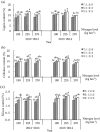Effect of nitrogen levels and nitrogen ratios on lodging resistance and yield potential of winter wheat (Triticum aestivum L.)
- PMID: 29117250
- PMCID: PMC5695594
- DOI: 10.1371/journal.pone.0187543
Effect of nitrogen levels and nitrogen ratios on lodging resistance and yield potential of winter wheat (Triticum aestivum L.)
Abstract
Lodging is one of the constraints that limit wheat yields and quality due to the unexpected bending or breaking stems on wheat (Triticum aestivum L.) production worldwide. In addition to choosing lodging resistance varieties, husbandry practices also have a significant effect on lodging. Nitrogen management is one of the most common and efficient methods. A field experiment with Yangmai 20 as research material (a widely-used variety) was conducted to study the effects of different nitrogen levels and ratios on culm morphological, anatomical characters and chemical components and to explore the nitrogen application techniques for lodging tolerance and high yield. Results showed that some index of basal internodes, such as stem wall thickness, filling degree, lignin content, cellulose content, water-soluble carbohydrate (WSC) and WSC/N ratio, were positively and significantly correlated with culm lodging-resistant index (CLRI). As the increase of nitrogen level and basal nitrogen ratio, the basal internodes became slender and fragile with the thick stem wall, while filling degree, chemical components and the strength of the stem decreased gradually, which significantly increased the lodging risk. The response of grain yield to nitrogen doses was quadratic and grain yield reached the highest at the nitrogen ratio of 50%:10%:20%:20% (the ratio of nitrogen amount applied before sowing, at tillering stage, jointing stage and booting stage respectively, abbreviated as 5:1:2:2). These results suggested that for Yangmai 20, the planting density of 180×104ha-1, nitrogen level of 225 kg ha-1, and the ratio of 5: 1: 2: 2 effectively increased lodging resistance and grain yield. This combination of planting density and nitrogen level and ratio could effectively relieve the contradiction between high-yielding and anti-lodging.
Conflict of interest statement
Figures



References
-
- Berry PM, Sterling M, Spink JH, Baker CJ, Sylvester-Bradley R, Mooney S, et al. Understanding and reducing lodging in cereals. Advances in Agronomy. 2004; 84(04): 215–269. doi: 10.1016/S0065-2113(04)84005-7 - DOI
-
- Peake AS, Huth NI, Carberry PS, Raine SR, Smith RJ. Quantifying potential yield and lodging-related yield gaps for irrigated spring wheat in sub-tropical Australia. Field Crops Research. 2014; 158(2): 1–14. doi: 10.1016/j.fcr.2013.12.001 - DOI
-
- Pinthus MJ. Lodging in wheat, barley and oats: the phenomenon, its causes and preventative measures. Advances in Agronomy. 1974; 25: 209–263. doi: 10.1016/S0065-2113(08)60782-8 - DOI
-
- Fischer RA, Stapper M. Lodging effects on high yielding crops of irrigated semi-dwarf wheat. Field Crops Research. 1987; 17(3): 245–258. doi: 10.1016/0378-4290(87)90038-4 - DOI
-
- Foulkes MJ, Slafer GA, Davies WJ, Berry PM, Sylvester-Bradley R, Martre P, et al. Raising yield potential of wheat. III. Optimizing partitioning to grain while maintaining lodging resistance. Journal of Experimental Botany. 2011; 62(2): 469–486. doi: 10.1093/jxb/erq300 - DOI - PubMed
MeSH terms
Substances
LinkOut - more resources
Full Text Sources
Other Literature Sources
Research Materials

